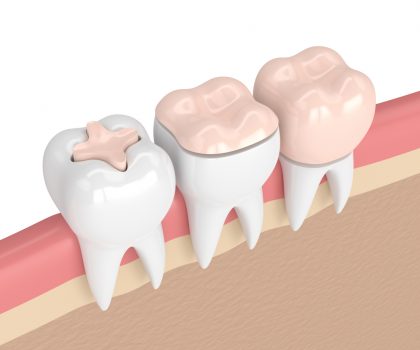Several times you lose the functionality and sensation of your teeth due to caries or external trauma. There are chances of missing a tooth entirely due to such reasons. To maintain the functionality and possess its purpose, the restoration of losing tooth structure is vital. This situation is where inlays and onlays aid the problem.
What Is An Inlay?
An inlay is an indirect filling or rehabilitation. It consists of a solid substance which is fitted to the cavity in the tooth and later cemented in its appropriate place. The material used can be gold, porcelain, or composite resin.

Sometimes, the decay or fracture in the tooth is so immense that the direct restoration is least recommendable. In such cases, the immediate recovery would affect the structural integrity of the tooth. It might also oppose the forces that help to bite. Thus, porcelain inlay or indirect gold restoration is adopted.
What Is An Onlay?
An Onlay is somewhat similar to the inlay. But it includes a replacement for the cusp of the tooth. It facilitates this by covering the area where the cusp which is missing would be.
An onlay is an indirect restoration which covers the missing cusps. At times when the decay or fracture in the areas of a tooth is inadequate for the composite restorations, then the onlay is prescribed and taken into consideration.
Like inlays, onlays are fabricated outside the mouth as well. It allows retaining the structure of the tooth.
Why Inlays And Onlays Are Considered A Conservative Alternative?
Wellington Dentist, Dr. Sam Sadati, suggests, “Some dentists use inlays and onlays as an alternative to dental crowns. These dental restorations are also known as indirect fillings. The usage and priority of its use over other alternatives are due to various benefits such as strength, long life, and a well-fitting solution. It is beneficial concerning the functional point of view as well.”
Inlays and onlays are useful in the treatment of tooth decay and structural damage. They are fabricated indirectly and then fitted at appropriate position whereas dental fillings are molded in its place in the mouth. Hence, the inlays and onlays serve as a conservative alternative.
How Are Inlays And Onlays Carried Out?
The treatment of carrying out inlays and onlays requires two visits.
- During the first visit, the impression of the damaged tooth is under observance. Then the restoration is fabricated in the dental laboratory. The material used for fabrication affects the appearance of finished restoration. A temporary or provisional restoration is created in this visit to aid the ultimate recovery.
- During the second visit, removing the temporary restoration is done in the first place. Then the inlay or onlay is placed appropriately. The dentist checks the bite to ensure that there are no problems after the treatment. Once the fitting process is over, the indirect restoration is then bonded.
What Are The Privileges Of Inlays And Onlays?
Following are some of the advantages of inlays and onlays which prove them to be a conservative approach:
- Quality fitting: They preserve the health of existing tooth and provide a stable structure for the same. In case of tooth decay whose intensity ranges from minimal to moderate, inlays and onlays prove to be a better choice offering stability and ease as compared to full coverage crowns.
- Maintain natural color: They don’t change the natural color of the tooth over time. Such phenomena are under observance in case of tooth-colored resin filling where tooth discoloration occurs over the period.
- Maintain tooth structure: The healthy tooth structure is maintained. Only the part of the tooth which is decayed and damaged is restored facilitating longevity regarding functionality. Hence, no harm is done to the healthy part of tooth further preserving it.
- Ease of tooth cleaning: The fitting is tailored to all the edges with inlays and onlays. Thus, it provides better coverage to clean them. An alternative such as composite fillings shrinks during the process of treatment whereas those of inlays or onlays don’t.
- Provision of strength: Onlays and inlays provide a stable solution to repair the tooth decayed. The material used in its preparation offer strength and an appropriate fit. It strengthens the damaged tooth for longevity.
- Protection of the weak tooth: An onlay often protects the tooth that has become weak. It does not require restructuring the entire tooth.
- Filling empty spaces: Inlays are better option to fill the area in the mouth usually between the teeth or lost tooth. It helps to keep the bacteria away which avoid further dental problems.
How Is The Future Of This Treatment Seen?
The materials used for the fabrication of inlays and onlays are evolving at an excellent rate to become like a natural tooth regarding its structure, life, and strength. The superb quality of longevity provided by this treatment ensures that it is not replaceable shortly.
There is scope for improvement in this procedure. The color of the tooth that changes over the period is enhance-able by improving the nature of materials used for it.
References:
- https://en.wikipedia.org/wiki/Inlays_and_onlays
- https://www.yourdentistryguide.com/inlays-and-onlays/
- http://floridassmiles.com/inlays-onlays/

